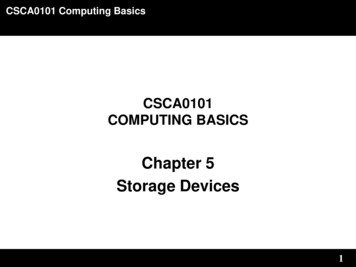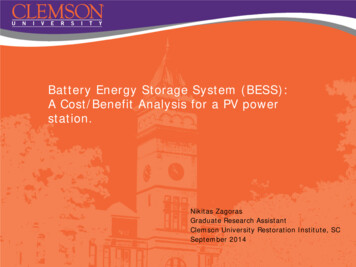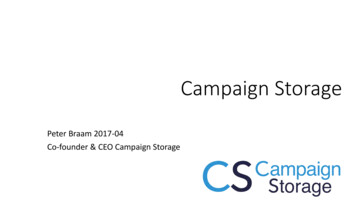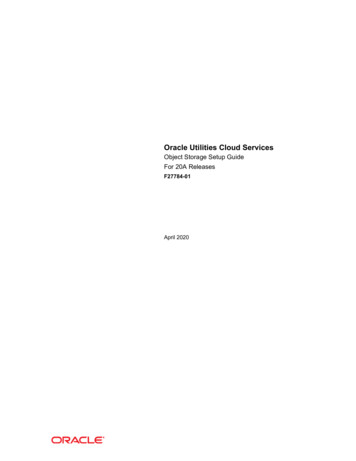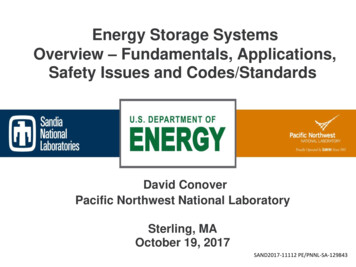
Transcription
Energy Storage SystemsOverview – Fundamentals, Applications,Safety Issues and Codes/StandardsDavid ConoverPacific Northwest National LaboratorySterling, MAOctober 19, 2017PNNLSAND2017-11112 PE/PNNL-SA-129843SA######/SAND#######
Purpose and Expected OutcomePurpose – To provide an overview of energy storage (ES) technology tailored forthose responsible for ensuring the safety of energy storage system (ESS) installationsExpected OutcomesA basic understanding of energystorage technologies –FUNDAMENTALSKnowledge about the variousapplications for energy storage in thebuilt environment – APPLICATIONSIdentification of safety-relatedissues associated with energystorage systems – SAFETY ISSUESIdentification of the standardsand codes applicable to energystorage systems – CODES ANDSTANDARDSSource - Southern California Edison
Energy Storage FundamentalsFUNDAMENTALSAn overview of the different types of ESS and how theyoperateElectro-chemicalThermalMechanical3
BASICSEnergy Storage TechnologiesEnergy – long discharges (min to hr) ala a “10K” Pumped Hydro Compressed AirEnergyStorage (CAES) Electrical Storage(Batteries) Sodium Sulfur (NaS)Flow BatteriesLead AcidAdvanced Lead CarbonLithium Ion Flywheels ElectrochemicalCapacitors4Power – short discharges (sec to min) ala a “100 m sprint”4
BASICSBattery BasicsBatteries store energy chemically andthrough electrochemical reactionsproduce electricity.The presence of an anode, cathode, andelectrolyte provides the basis for storingenergy and satisfying energy loads.There are a wide range of battery types,sizes, designs, operating temperatures,control mechanisms, and chemistries.Beyond storing energy, all batteries arenot created equal.Source – Kamath, EPRI ES Technology Overview5
BASICSElectro-chemical ESS TypesLead-Acid (LA) Batteries – twoelectrodes (one lead and one leaddioxide) immersed in sulfuric acidNickel-Cadmium (Ni-Cd) Batteries – twoelectrodes (one nickel and onecadmium) immersed in an aqueouspotassium-hydroxide electrolyteLithium-Ion (Li-ion) Batteries – twoelectrodes (varying chemistries)Na-Metal Batteries – consisting of amolten sodium anode and β"-Al2O3 solidelectrolyteRedox Flow Batteries – two electrolytesare stored in separate tanks and arepumped to a fuel cell when energy isdesired6
BASICSThermal and Mechanical ESS Pumped hydroelectric storage – energy is stored in theform of a water reservoir at a higher altitude that isreleased through turbines to a lower reservoir and ispumped back up to the higher reservoir during periodsof low energy demand. Flywheels – a spinning mass in its center that is drivenby a motor. When energy is needed, the spinning forcedrives a turbine, which slows the rate of rotation. Thesystem is recharged by a motor.DOE/EPRI 2013 Electricity Storage Handbookin Collaboration with NRECA Molten salt – formulationscomposed of mixtures ofnitrates or nitrites that canstore heat and then usethat heat to powerturbines to generateelectric power.SAND2015-10759 “Recommended Practices forthe Safe Design and Operation of /SAND2015-10759.pdf7
Key TakeawaysFUNDAMENTALSThere are a wide range of energy storage technologies todayand there will be more in the future.Energy, economic, and environmental issues are creating ademand for energy storage, and policy initiatives areaccelerating that demand.Energy storage includes batteries but also thermal andmechanical technologies.Beyond storing energy, all batteries are not the same.The wide range of battery types, chemistries, sizes, designs,control mechanisms, operating temperatures, and potentiallocations suggest an almost infinite number of possibilities.Just when you think you have all the information you needthere will be new energy storage technologies to keep youengaged.8
Applications of Energy Storage SystemsAPPLICATIONSAn overview of where and how ESS are being applied9
APPLICATIONSSCE DESI SiteConnectionPointBESS BuildingPCS12 kV/480 VTransformerSwitchgearSource - Southern California Edison10
APPLICATIONSSCE DESI ESSKey Components Battery System Power Conversion System(PCS) Medium VoltageTransformer Medium VoltageSwitchgear and Protection12 kV SwitchgearSource - Southern California EdisonBattery SystemFire SuppressionSystemPCS11
APPLICATIONSAuwahi Wind Farm, HI Project Name:Location:Application:ES Type:Power Rating:Energy Capacity:Battery Package:AuwahiMaui, HawaiiWind ramp managementGSS HR (high power lithium ion)11 MW4.3 MWhStandard containerized (9x NEC GBS grid battery systemcontainers)Power Conversion: 3x inverters in outdoor-rated cabinetsBalance of Plant:Chilled water unit for battery thermal managementTransformers and switchgear appropriate to substationCommercialDecember 2012Operation:12
ESS Application ExamplesAPPLICATIONSXtreme Power ESS at a Castle & Cooke – 1.5 MWDC/1.2 MW AC advanced lead-acid battery thatdoubles the output of the solar system and control theramp rate.ZZB Energy Corporation at Hawaiian Properties –60 kW zinc bromine flow battery that is part of anelevator system in an R-2 building that uses grid powerand power from a 20 kW PV array.Iron Edison at Confidential – 48 kW nickel iron batterypowered by a pole-mounted solar array.Maxwell Technologies at Long Island RR – electrochemical capacitor to provide voltage support to assisttraction power system (capture and store energyproduced by trains to help with acceleration).SAFT at Scripps Ranch Community Center –30 kW lithium-ion ESS used for PV energy storage.Mitsubishi at Santa Clara Data Center – 1.5 kWelectro-chemical VLRA applied as a UPS.13DOE ESS Database http://www.energystorageexchange.org/
Database of change.org/14
Safety IssuesSAFETY ISSUESSiting (location, loads, protection, egress/access, maximum quantitiesof chemicals, separation, etc.).New versus existing systems and new versus existing building/facilityapplications.Stationary, mobile, and portable systems vary in application and use.Ventilation, thermal management, exhausts (when necessary, flowrates, how controlled, etc.).Interconnection with other systems (energy sources, communications,controls, etc.).Fire protection (detection, suppression, containment, smoke removal,etc.).Containment of fluids (from the ESS and from incident response).Signage, markings, and security.Identification of the applicable authorities having jurisdiction (utility,federal, state or local government, etc.).15
SAFETY ISSUESSafety TakeawaysEnergy storage technologies may or may not be similar to othertechnologies; the system and its component parts must bevalidated as being safe.The safety of an energy storage technology is also affected bythe location in which it is installed and manner in which thatinstallation is implemented.While there are a set number of safety issues, the manner inwhich they are addressed to ensure safety is significant due tothe number of variables associated with the technologies andtheir relationship with the built environment.Safety does not stop when a new system is commissioned, andthe safety issues remain relevant through operation, repair, orrenewal of the system, any needed recommissioning, andfinally through decommissioning.16
Model Codes and StandardsCODES AND STANDARDSModel codes and standards in the aggregate address the design,construction, commissioning, rehabilitation, operation, maintenance,repair, and demolition of components of the built environment, such asbuildings, facilities, products, systems, and equipment therein.Standards each have a very specific scope and where needed willreference other standards.Model codes reference standards.Regulations, rules, laws, specifications, tariffs, contracts, and othermeans are the vehicles by which those model codes and standardsare adopted.When adopted, the model codes and standards must be satisfiedsubject to any penalties associated with noncompliance.17
CODES AND STANDARDSU.S. Model Codes and StandardsCover the built environment atlarge and that includes the ESSOverarchingCSCS for ESSInstallationAddress theinstallation of the ESSin relation to othersystems and the builtenvironmentCS forComplete ESSThe entire ESSin the aggregateCS for ESSComponentsComponents associatedwith or part of the ESS18
CODES AND STANDARDSU.S. Model Codes and StandardsOverarchingCSNFPA 1-15 – Fire Code 70-17 – National Electric Code 5000-15 – Building CodeICC 2015 International Fire Code 2015 International Residential Code 2015 International Mechanical Code 2015 International Building CodeIEEE C2-17 – National Electrical Safety Code19
CODES AND STANDARDSU.S. Model Codes and StandardsNFPA 855-X – Standard for the Installation ofStationary Energy Storage SystemsCS for ESSInstallationNECA 416-17 – Recommended Practice forInstalling Stored Energy SystemsIEEE 1653-2012 – Guide for Ventilation andThermal Management of Batteries forStationary Applications P1578 Recommended Practice forStationary Battery Electrolyte SpillContainment20
CODES AND STANDARDSU.S. Model Codes and StandardsASME TES-1 – Safety Standard forThermal Energy Storage SystemsCS forComplete ESSNFPA 791-14 – Recommended Practiceand Procedures for UnlabeledElectrical EquipmentUL 9540 – Safety of ES Systems andEquipment21
CODES AND STANDARDSU.S. Model Codes and StandardsULCS for ESSComponents 810A – Electrochemical Capacitors 1642 – Standard for Lithium Batteries 1741 – Inverters, Converters, Controllers andInterconnection System Equipment for Usewith Distributed Energy Resources 1973 – Batteries for Use in LER and StationaryApplications 1974 – Evaluation of Batteries for RepurposingCSA CSA C22.2 No. 107.1-2016 – Power ConversionEquipmentIEEE P1697.1 Guide for the Characterization andEvaluation of Lithium-Based Batteries inStationary Applications IEEE P1679.2 Guide for the Characterization andEvaluation of Sodium-Beta Batteries inStationary Applications22
CODES AND STANDARDSU.S. Model Codes and StandardsOngoing information aboutmodel codes and standards isprovided through . Regular webinars involvingthe relevant standardsdevelopment organizations A monthly codes andstandards report23
CODES AND STANDARDSKey TakeawaysDevelopment and maintenance of U.S. model codes andstandards is an ongoing process open to all interested partiesand is facilitated by a number of standards developmentorganizations.Advancements in energy storage technology and lessonslearned from existing system installations will necessitatecontinual updating and enhancement of codes and standards.Once codes and standards are published there are a myriad ofentities that will adopt and focus on ensuring compliance withthose codes and standards.Participation by all relevant parties in the development, adoption,and implementation of codes and standards will help ensureenergy storage technology can be deployed safety and in atimely less complicated manner.24
SummaryEnergy storage technology development and deployment are dynamic andtouch on a number of critical safety issues.Due to energy, economic, and environmental influences a significantincrease in the application of energy storage systems can be expected inthe near term and beyond.Traditional roles determined based on the location of a technology relative tothe electric meter are likely to become more complex.While safety issues have been and are being identified, the informationnecessary to define how to address each one for each technologyapplication many not exist, thereby driving the need for additional research.Codes and standards are updated regularly and are available for adoption tohelp ensure system safety as designed, installed, and during/after safetyrelated incidents.Gaps between what we know and can prescribe in codes and standards canbe filled through testing, failure modes and effects analysis, hazardmitigation guidance, and collaboration by all interested parties to addresssafety issues.25
WebsiteFor more information aboutEnergy Storage Safety effortsvisit our websiteThe goal of the energy storagesafety effort is to“Foster confidence in thesafety and reliability ofenergy storage ty/26
AcknowledgmentDr. Imre Gyuk, DOE-Office of ElectricityDelivery and Energy ReliabilitySandia National Laboratories is a multi-mission laboratory managed and operated by National Technology and Engineering Solutions of Sandia, LLC.,a wholly owned subsidiary of Honeywell International, Inc., for the U.S. Department of Energy’s National Nuclear Security Administration undercontract DE-NA-0003525.27
ThanksFor more information about DOE OE ESS safety activitiescontactenergystorage@sandia.gov28
Purpose - To provide an overview of energy storage (ES) technology tailored for those responsible for ensuring the safety of energy storage system (ESS) installations Expected Outcomes A basic understanding of energy storage technologies - FUNDAMENTALS Knowledge about the various applications for energy storage in the




